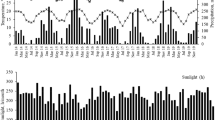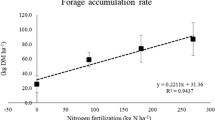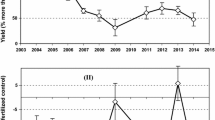Abstract
In pot experiments with greatly differing rates of N, P, S, K and Ca, dry matter (DM) yields of leek stems varied from 25 to 164 g/pot. Total-N and NO3-N concentrations varied from 1.18 to 3.56% and from 10 to 1515 ppm in DM, respectively. Both N applications and P and K deficiency greatly increased total-N and NO3-N content. S applications increased total-S content from 0.047 to 0.359% in DM, of which between approximately 100 to 25% were found in methionine+cystine. Total-N/total-S ratios decreased from 57 to 6 with the highest S level. P and K applications increased their respective content in DM two- and threefold. Severe Ca deficiency reduced Ca content from 0.495 to 0.045%. Iron, zinc, manganese and copper contents varied from 33–69, 14–26, 11–34 and 3.1–5.7 ppm in DM, respectively. Increasing N contents, whether due to N applications or P or K deficiency, decreased the content of all essential and some other amino acids in crude protein. Both S and severe P deficiency had a pronounced negative effect on amino acid composition and chemical score. Only glutamic acid (glutamine) and arginine were increased by increasing N contents. However, expressed as g/kg DM the concentrations of all amino acids were positively correlated with protein content. S and P deficiency reduced total dietary fibre (TDF) content of DM from 28.3 to 18.6% and 17.4%, respectively, of which between 53 and 60% were insoluble dietary fibre (IDF). Digestible energy (DE) was positively correlated with protein content (r=0.90**). In N-balance trials with rats, increasing protein concentrations (50% of total protein given as casein and supplemented with 1% methionine) raised the true digestibility (TD) of the protein from 44 to 72%. The biological value (BV) of protein was generally high, with a mean of 91.7 N deficiency tended to increase and S deficiency tended to decrease the BV.
Similar content being viewed by others
References
Eppendorfer WH (1978) Effects of N-fertilization on amino acid composition and nutritional value of spinach, kale, cauliflowers and potatoes. J Sci Food Agric 29: 305–311.
Hansen H (1978) The influence of nitrogen fertilization on the chemical composition of vegetables. Qual Plant Plant Foods Hum Nutr 28: 45–63.
Greenwood DJ, Hunt J (1986) Effect of nitrogen fertilizer on the nitrate contents of field vegetables grown in Britain. J Sci Food Agric 37: 373–383.
Eppendorfer WH, Eggum BO (1992) Dietary fibre, sugar, starch and amino acid content of kale, ryegrass and seed of rape and field beans as influenced by S- and N-fertilization. Plant Foods Hum Nutr 42: 359–371.
Greenwood DJ, Cleaver TJ, Turner MK, Hunt J, Niendorf KB, Loquens SHM (1980) Comparison of the effects of nitrogen fertilizer on the yield, nitrogen content and quality of 21 different vegetables and agricultural crops. J Agric Sci Camb 95: 471–485.
Maynard DN, Barker AV, Minotti PL, Peck NH (1976) Nitrate accumulation in vegetables. Adv Agron 28: 71–118.
Mortensen J, Eriksen J (1994) Effect of sulphur deficiency on amino acid composition. Norw J Agric Sci Supplement No 15: 135–142.
Schnug E, Haneklaus S (1994) The ecological importance of plant sulphur supply. Norw J Agric Sci Supplement No 15: 149–156.
Scott NM, Watson ME (1982) Agricultural sulphur research and responses to sulphur in North Scotland. In: Moore AI (ed), Intern Sulphur '82 Conf Proc Vol I. The British Sulphur Corporation Ltd, pp 579–586.
Best EK (1976) An automated method for determining nitrate nitrogen in soil extracts. Queensl J Agric Anim Sci 33: 161–166.
Stuffins CB (1967) The determination of phosphate and calcium in feed stuffs. Analyst 92: 107–111.
AOAC (1975) Official Methods of Analyses. 11th ed. Washington, DC: Association of Official Analytical Chemists.
Asp NG, Johansson CG, Helmer H, Siljestrøm MJ (1983) Rapid enzymatic assay of insoluble and soluble dietary fibre. J Agric Food Chem 31: 476–482.
Mason VC, Bech-Andersen S, Rudemo M (1980) Hydrolysate preparation for amino acid determination in feed constituents. Z Tierphysiol Tierernährg Futtermittelkd 43: 146–164.
Eggum BO (1973) A study of certain factors influencing protein utilization in rats and pigs. Beretn nr 406, Nat Inst Anim Science (Copenhagen) 173 pp.
Greenwood DJ, Draycott A (1989) Experimental validation of an N-response model for widely different crops. Fertilizer Research 18: 153–174.
Hara T, Koji S, Yoji S (1981) Nutritional relationship between nitrogen and sulphur in cabbage (Brassica oleracea L. var.capitata L.). J Jap Sco Hort Sci 50: 60–65.
Eppendorfer W (1969) The effects of nitrogen and sulphur on dry matter yields of barley plants, on total-N and -S concentrations in grain and straw, and on cystine and methionine contents of grain. Yearbook 1969. R Vet and Agric Univ, Copenhagen, pp 100–116.
Eppendorfer WH, Eggum BO (1994) Dietary fibre, starch, amino acids and nutritive value of potatoes as affected by sulphur, nitrogen, phosphorus, potassium, calcium and water stress. Acta Agric Scand Sect B Soil and Plant Sci 44: 107–115.
Miller DS, Donoso G (1963) Relationships between the sulphur/nitrogen ratio and the protein value of diets. J Sci Food Agric 14: 345–349.
Mengel K, Kirkby EA (1987) Principles of Plant Nutrition. International Potash Institute: Bern Switzerland, pp 136–138.
Wünsch A (1975) Freie Aminosäuren und Proteinaminosäuren in Blatt-, Wurzelgemüsen und Kartoffeln. Landwirtsch Forsch 28: 345–358.
Eppendorfer WH (1977) Effects of varying amounts of sulphur and nitrogen on yields, N/S ratio and amino acid composition of successive cuts of Italian ryegrass. Yearbook 1977. R Vet and Agric Univ, Copenhagen, pp 42–57.
FAO/WHO (1973) Energy and Protein Requirements. FAO Food and Nutrition Series No 7. Food and Agriculture Organization of the United Nations, Rome.
Block RJ, Mitchell HH (1946) The correlation of the amino acid composition of proteins with their nutritive value. Nutr Abstr Rev 16: 249–278.
Eppendorfer WH, Eggum BO (1995) Effects of nitrogen, phosphorus, sulphur, potassium, calcium and water stress on yield, mineral and amino acid compositions, dietary fibre and nutritive value of carrots. Acta Agric Scand Sect B Soil and Plant Sci 45: 124–131.
Brunsgaard G, Kidmose U, Sørensen S, Kaack K, Eggum BO (1994) The influence of variety and growth conditions on the nutritive value of carrots. J Sci Food Agric 65: 163–170.
Author information
Authors and Affiliations
Rights and permissions
About this article
Cite this article
Eppendorfer, W.H., Eggum, B.O. Fertilizer effects on yield, mineral and amino acid composition, dietary fibre content and nutritive value of leeks. Plant Food Hum Nutr 49, 163–174 (1996). https://doi.org/10.1007/BF01091974
Received:
Accepted:
Issue Date:
DOI: https://doi.org/10.1007/BF01091974




